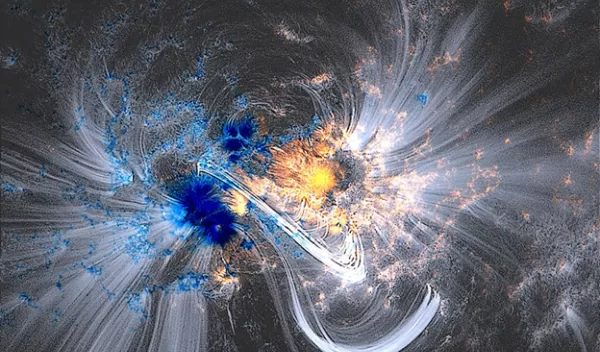
Laboratory solar flares reveal clues to bursts of high-energy particles from space
Simulating solar flares on a scale the size of a banana, U.S. National Science Foundation-supported researchers at Caltech have parsed out how these massive explosions blast potentially harmful energetic particles and X-rays into the cosmos.
Coronal loops are arches of plasma that protrude from the surface of the sun, aligned along magnetic field lines. The lines act like highways for charged particles, guiding the motion of the electrons and ions that comprise plasma.
The loops, which may project 100,000 kilometers above the sun's surface, can persist for minutes to hours. The loops usually grow and evolve slowly but sometimes can abruptly blast a tremendous amount of energy — billions of times stronger than the most powerful nuclear explosion on Earth — into space. This sudden blast of energy is called a solar flare.
Some of the energy in the flare takes the form of charged particles and "hard X-rays," which are high-energy electromagnetic waves like those used to image bones in a doctor's office. The Earth's own magnetic field and atmosphere act as a shield that protects life on the surface from being cooked by these torrents of energy, but they sometimes disrupt communications and power grids. They also pose a threat to spacecraft and astronauts in space.
While the fact that solar flares generate energetic particles and X-ray bursts has long been known, scientists are only starting to piece together the mechanism by which they do so.
Researchers have two options for deciphering how and why coronal loops form and change. The first is to observe the sun and hope to capture the phenomenon in sufficiently fine detail to yield relevant information. The second is to simulate the loops in a lab. Caltech's Paul Bellan, an applied physicist, chose the latter.
Bellan and other scientists built a vacuum chamber with twin electrodes inside. To simulate the phenomenon, they charged a capacitor with enough energy to run the City of Pasadena for a few microseconds, then discharged it through the electrodes to create a miniature solar coronal loop.
Each loop lasts about 10 microseconds and has a length of about 20 centimeters and a diameter of about 1 centimeter. But structurally, the loops are identical to the real thing, providing the opportunity to simulate and study them at will. A key recent discovery is that each solar coronal loop is not a single structure but is composed of fractally braided strands akin to large ropes, a structure reproduced in the lab.
"Each experiment consumes about as much energy as it takes to run a 100-watt lightbulb for about a minute, and it takes just a couple of minutes to charge the capacitor up," says Bellan, the senior author of a paper on solar flares published in Nature Astronomy. Bellan captures each loop with a camera capable of taking 10 million frames per second, and then studies the resulting images.
"The ability to reproduce and study the physics of the sun in a laboratory is a significant step forward," says Vyacheslav (Slava) Lukin, an NSF Plasma Physics program director. "By relating laboratory measurements to solar observations, we learn more about the sun while exploring fundamental questions about plasma and its possible uses on Earth."
